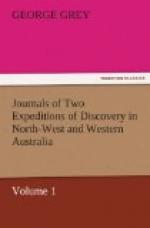NEW KANGAROO.
I shot a female kangaroo of the Petrogale brachyotis near Hanover Bay, and by the preservation of the skin and other parts enabled Mr. Gould to identify it as a new species.
This graceful little animal is excessively wild and shy in its habits, frequenting, in the daytime, the highest and most inaccessible rocks, and only descending into the valleys to feed early in the morning and late in the evening. When disturbed in the daytime amongst the roughest and most precipitous rocks, it bounds along from one to the other with the greatest apparent facility, and is so watchful and wary in its habits that it is by no means easy to get a shot at it. One very surprising thing is, how it can support the temperature to which it is exposed in the situations it always frequents amongst the burning sandstone rocks, the mercury there during the heat of the day being frequently at 136 degrees. I have never seen these animals in the plains or lowlands, and believe that they frequent mountains alone.
NEW DOMESTIC DOG.
The new species of dog differs totally from the Dingo or Canis australiensis. I never saw one nearer than from twenty to thirty yards, and was unable to procure a specimen. Its colour is the same as that of the Australian dog, in parts however having a blackish tinge. The muzzle is narrow, long, thin, and tapers much, resembling that of a greyhound, whilst in general form it approaches the English lurcher. Some of the party who went to Timor stated it to resemble precisely the Malay dog common to that island, and considered it to be of the same breed; which I think not improbable, as I cannot state that I ever saw one wild, or unless in the vicinity of natives; in company with whom they were generally observed in a domesticated state. On the other hand the Canis australiensis was common in some parts in a state of nature: of these I saw several myself and, from the descriptions given by other individuals of the party of dogs they had observed, I recognised their identity with the same species. We heard them also repeatedly howling during the night and, although they never attacked our sheep or goats, many portions of dead animals were carried off by them. I saw but two flying squirrels and know not to which species of Petaurista they are to be referred.
OTHER ANIMALS.
Both mice and rats are common, the former precisely resembling in appearance the English fieldmouse. The rats on one occasion ate up a live pet parakeet, leaving the bones gnawed and strewed about; and on another, when I had shot a crane (Ardea scolopacea) intending it for breakfast, they in the night devoured nearly the whole of it.
CHECKS ON INCREASE OF ANIMALS.
The multiplication of kangaroos, opossums, rats, etc. may be checked by various causes; but man, I imagine, is the most deadly enemy they have to contend with. The numerous remains of these animals that I have seen about the native fires attest the number destroyed. In all those caves in which I found native paintings were representations either of kangaroo hunts, or of men bringing down these animals dead on their shoulders; and many a hollow tree bore witness of its having been smoked in order to drive forth to certain death the trembling opossum or bandicoot rat which had taken refuge in it.




